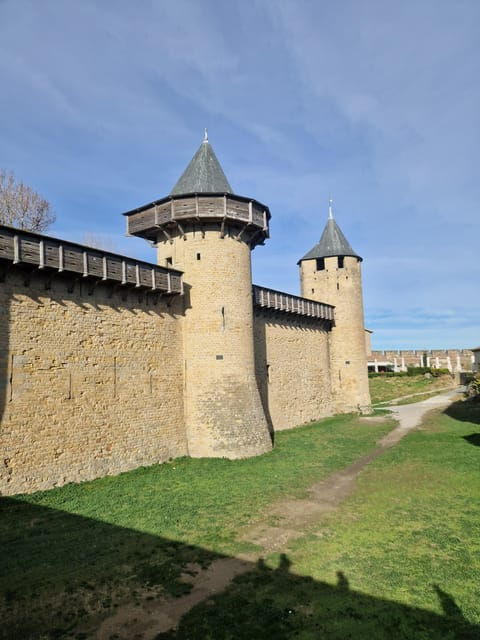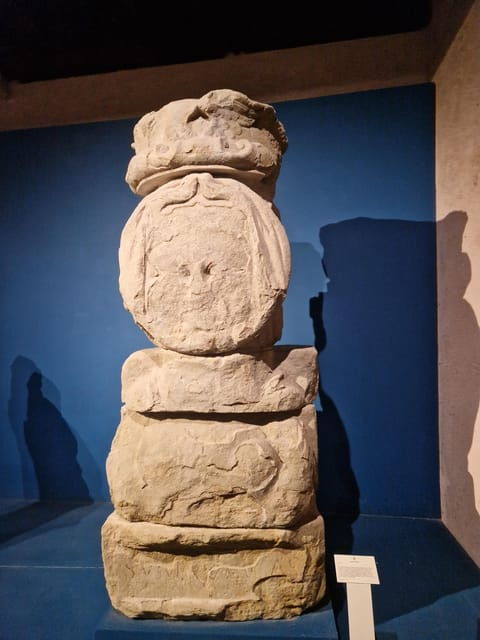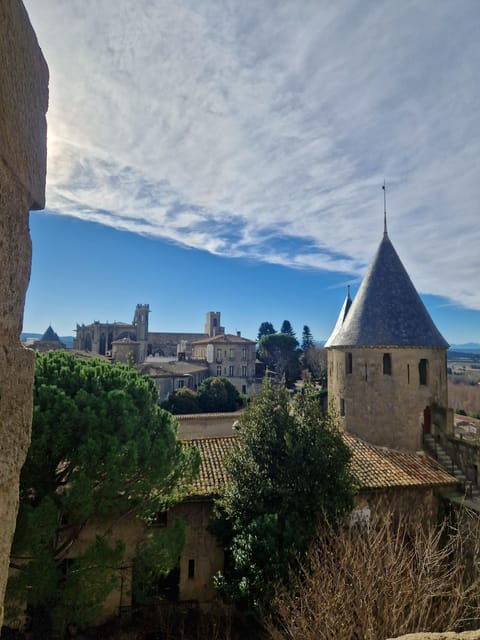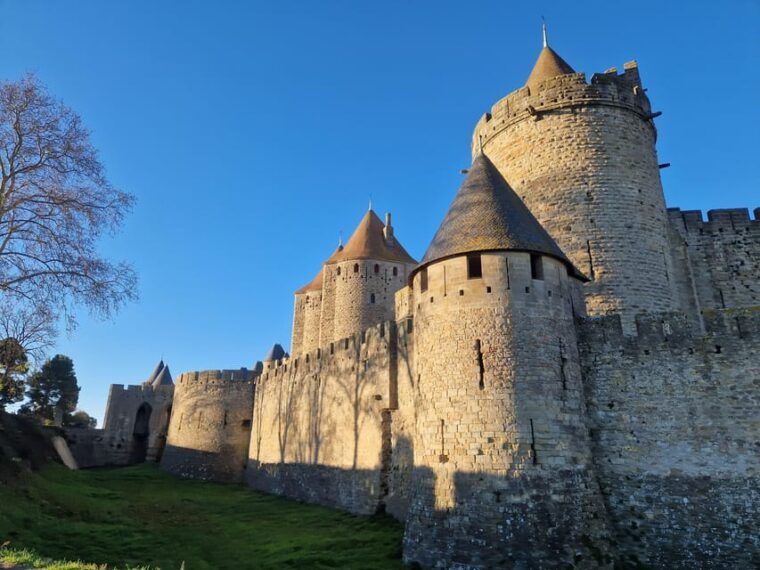Carcassonne stands as a testament to medieval ingenuity, its striking architecture drawing countless visitors each year. Eugène Viollet-le-Duc’s restoration in the 19th century breathed new life into this ancient city, merging Gothic and Romanesque styles seamlessly. As you wander the cobblestone streets, the history whispers through the air, inviting exploration of sites like the Basilica of Saint-Nazaire. But what else lies hidden within its storied walls?
Good To Know

- Carcassonne is a UNESCO World Heritage site, renowned for its fortified medieval architecture, dating back to Roman times.
- Eugène Viollet-le-Duc led a significant 19th-century restoration, enhancing the city’s aesthetic while preserving its historical integrity.
- The restoration included the revival of towers, walls, and gates, blending creativity with historical authenticity.
- Key architectural features include the Porte Narbonnaise, the Basilica of Saint-Nazaire-Saint-Celse, and Château Comtal, showcasing Gothic and Romanesque styles.
- Exploring Carcassonne’s narrow medieval streets reveals charming boutiques, cafés, and captivating details that narrate its rich history.
The Historical Significance of Carcassonne

When visitors stroll through the enchanting streets of Carcassonne, they’re not just wandering through a picturesque medieval city; they’re stepping into a rich tapestry of history that dates back to Roman times.
This fortified town played a crucial role in regional defense, acting as a strategic stronghold during various conflicts. Its impressive walls and towers tell stories of battles fought and won.
Over centuries, Carcassonne’s architecture evolved, reflecting the influences of different cultures and eras.
Today, it stands as a UNESCO World Heritage site, captivating anyone who dares to explore its narrow alleyways and historical landmarks, each whispering tales of the past.
Want to see more of Carcassonne? Other city tours we've reviewed
The Restoration by Viollet-le-Duc

Although Carcassonne’s medieval city had already stood the test of time, it was the visionary architect Eugène Viollet-le-Duc who truly brought it back to life in the 19th century.
His passion for medieval architecture sparked a massive restoration project, transforming the crumbling fortress into a stunning spectacle.
Eugène Viollet-le-Duc’s dedication to medieval architecture rejuvenated Carcassonne, turning its ruins into a breathtaking marvel.
Viollet-le-Duc focused on enhancing the city’s aesthetic while preserving its historical essence. He meticulously restored towers, walls, and gates, often blending imagination with reality.
This revitalization not only attracted travelers but also instilled a sense of pride in the local community, ensuring Carcassonne’s legacy would endure for generations to come.
Key Architectural Features

The restoration by Viollet-le-Duc not only revived Carcassonne’s medieval charm but also highlighted its impressive architectural features.
Towering ramparts, crowned with watchtowers, showcase the city’s formidable past, while the intricate stonework and vibrant stained glass of the Basilica of Saint-Nazaire-Saint-Celse draw the eye.
The Porte Narbonnaise, with its grand entrance, invites visitors to explore further into this enchanting world.
Each structure reflects a blend of Gothic and Romanesque styles, creating a captivating visual narrative.
Viollet-le-Duc’s attention to detail ensures that every corner of Carcassonne tells a story of resilience and artistry, making it a true architectural gem.
Exploring the Narrow Medieval Streets
As visitors wander through the narrow medieval streets of Carcassonne, they get a real sense of stepping back in time.
The cobblestones beneath their feet echo stories of knights and merchants, while the towering stone walls loom overhead, creating a cozy yet grand atmosphere.
Tiny boutiques and cafés line the alleys, inviting explorers to pause and savor local delights.
Every twist and turn reveals charming details, like wrought-iron balconies and colorful flower boxes.
It’s easy to lose track of time here, immersed in the rich history and vibrant energy that fills these enchanting streets, making every step an adventure.
More Great Tours NearbyMust-See Sites: Porte Narbonnaise and Basilica
Wandering through Carcassonne’s narrow streets naturally leads visitors to two of its standout landmarks: the Porte Narbonnaise and the Basilica of Saint-Nazaire-Saint-Celse.
The Porte Narbonnaise, with its impressive towers and fortified gate, offers a taste of medieval defense, inviting all to imagine the bustling activity of centuries past.
Just a short stroll away, the Basilica enchants with its stunning stained-glass windows and intricate architecture. This place isn’t just a feast for the eyes; it’s steeped in history and spirituality.
Together, these sites capture the essence of Carcassonne’s charm, making them must-sees for any visitor.
- Carcassonne: First Discovery Walk and Reading Walking Tour
- Guided Tour of the City of Carcassonne (On Foot)
- Ghosts of the Citadel Outdoor Escape Game in Carcassonne
- Day Tour to Mirepoix, Montségur, Camon. Private Tour From Carcassonne
- Carcassonne S Medieval Walls: a Self-Guided Tour
- Private Tour With a Knight
The Château Comtal and Its Defense Mechanisms
Nestled within the fortified walls of Carcassonne, Château Comtal stands as a testament to medieval ingenuity and power.
This impressive fortress boasts towering walls, a deep moat, and a series of robust towers designed to keep intruders at bay. Visitors can’t help but admire the strategic layout, featuring narrow passageways and hidden arrow slits, perfect for defending against attacks.
The castle’s imposing gates served as a first line of defense, while the surrounding ramparts offered an eagle-eye view of the landscape.
It’s easy to see why Château Comtal remains a symbol of strength, captivating all who wander its storied grounds.
Additional Attractions in Carcassonne
While exploring the enchanting city of Carcassonne, visitors discover a treasure trove of additional attractions that complement the awe-inspiring medieval architecture. Beyond the Château Comtal, they can explore the Inquisition Museum, wander through narrow streets, or even brave a haunted house. Each spot offers a unique glimpse into the city’s rich history and culture.
Here’s a quick glance at some of these attractions:
| Attraction | Admission Fee | Highlights |
|———————|—————|——————————|
| Château Comtal | €13 | Stunning views, rich history |
| Inquisition Museum | €11 | Dark tales, intriguing exhibits |
| Haunted House | €10 | Thrills and chills await |
| Ramparts | Free | Scenic walks, breathtaking views |
Visitor Experience and Accessibility
As visitors step into the enchanting medieval city of Carcassonne, they’re immediately captivated by its towering ramparts and narrow cobblestone streets, which transport them back in time.
To enhance their experience, visitors can enjoy:
Visitors can enhance their journey with guided tours, flexible bookings, and access to captivating historical sites.
Guided tours in French or English, lasting 1.5 hours.
Flexible booking options, including free cancellation up to 24 hours before.
Access to fascinating sites like the Basilica of Saint-Nazaire-Saint-Celse and the Château comtal exterior.
However, it’s important to note that the tour isn’t suitable for those with mobility impairments, and the meeting point is conveniently located in front of the statue of Dame Carcas.
Frequently Asked Questions
What Are the Tour’s Available Starting Times?
The tour offers flexible starting times, making it easy for groups to find a slot that fits their schedule. Travelers can check availability online and plan their medieval adventure without hassle or stress.
Can I Book the Tour for a Private Group?
They can absolutely book the tour for a private group! With flexible arrangements and a maximum of 20 participants, it’s a great way to explore together. Just check availability and get ready for an adventure!
Is There a Guide Available in Languages Other Than French and English?
They wondered if a guide spoke languages beyond French and English. Unfortunately, the tour only offers those two options, leaving non-speakers at a disadvantage. Still, the experience remains unforgettable with the right language skills.
How Long Does the Tour Last?
The tour lasts 1.5 hours, giving visitors plenty of time to explore the fascinating medieval city. They’ll wander through narrow streets, admire stunning architecture, and soak up the rich history of the area.
Is There a Restroom Available During the Tour?
During the tour, there isn’t a restroom available, so it’s best to plan ahead. Guests should consider using facilities before starting, ensuring they can fully enjoy the experience without any interruptions.
The Sum Up
To sum it up, Carcassonne isn’t just a feast for the eyes; it’s a journey through time. Viollet-le-Duc’s restoration turned this medieval gem into a captivating blend of history and artistry. Wandering its cobblestone streets, visitors can’t help but feel the echoes of the past. From the majestic ramparts to the stunning Basilica, every corner reveals a story waiting to be discovered. So, if you’re looking for an adventure steeped in history, Carcassonne should be at the top of your list!
You can check availability for your dates here: More Great Tours NearbyMore City Tours in Carcassonne
More Tour Reviews in Carcassonne
- Vintage Solex EN ride in Carcassonne
- Carcassonne: 2-Hour Best Intro Walking Tour with a Local
- Carcassonne: 1h30 Walking Tour of the Medieval City
- Carcassonne: Wine Tasting of the Languedoc Roussillon
- Carcassonne: Solex ride with guide and French-style brunch
- Carcassonne Small Group Half-day tour from Toulouse
Looking for something different? Other Carcassonne activities we've written about
- Vintage Solex EN ride in Carcassonne
- Carcassonne: 2-Hour Best Intro Walking Tour with a Local
- Carcassonne: 1h30 Walking Tour of the Medieval City
- Carcassonne: Wine Tasting of the Languedoc Roussillon
- Carcassonne: Solex ride with guide and French-style brunch
- Carcassonne Small Group Half-day tour from Toulouse
- Carcassonne: Solex tour with guide and wine tasting
- Carcassonne: Express Walk with a Local in 60 minutes
- Self-Guided Walking Tour in Carcassone Medieval Town
- Private Conference Tour of the City of Carcassonne
- Carcassonne: Secrets of the Castle’s Defense Self-Guided Tour
- Carcassonne Scavenger Hunt and Highlights Self-Guided Tour
